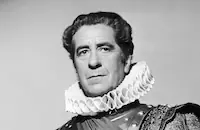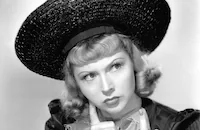Not Exactly Gentlemen
Cast & Crew
Benjamin Stoloff
Victor Mclaglen
Fay Wray
Lew Cody
Robert Warwick
Edward Gribbon
Film Details
Technical Specs

Synopsis
In 1877, thieves Ace Beaudry, Bronco Dawson and Bull Stanley head West together after having each been betrayed by a woman. They come across a wagon train bound for the town of Custer, where hundreds of people are gathering for a land rush in the Dakotas, which President Ulysses S. Grant has opened to settlers thanks to a treaty with the Sioux Indians. After the three rogues ride off, they spy a lone wagon with a tempting string of thoroughbreds. Before they can steal the horses, however, the wagon is attacked by a gang led by Layne Hunter, a shifty saloon owner from Custer. The trio chase off the gang, and as they are about to abscond with the horses, they find pretty Lee Carleton, whose father was killed in the attack. Believing that the men are her rescuers, Lee tells them that she and her father were traveling to Custer to file a claim on a gold mine. Bull and his pals escort Lee to Custer and help her set up camp in preparation for the next morning's land rush. Determined to get their hands on the gold mine, the trio decides that one of them must marry Lee. They cut cards to see who will propose first, and Bronco, much to his dismay, wins. Lee gently turns him down, telling him that he is like a brother to her. She tells the same thing to Ace and then to Bull, who is genuinely interested in her. He confesses that he and his friends "ain't exactly gentlemen," but her faith in them is not swayed. Meanwhile, Hunter's henchman Nelson spies on the group and learns of the map. Bronco and Ace decide to find Lee a husband whom they can kill after he gains the title to the mine, and they search for an eligible candidate in the saloon. They return with Bull to the camp, where they see Lee kissing her fiancé, Bruce Randall, who has come from the East. Overjoyed that the map will soon be owned by a fair competitor, the men bid Lee goodnight and promise to treat Bruce "like a gold mine." Hunter and his men capture Lee in the night, however, then steal her map, and send some of their numbers to cross the line before the land rush and block the pass, while Hunter remains waiting for the signal to cross the line legally. Bull and Bruce rescue Lee from the saloon, and Lee, knowing the map by heart, leads the men on a furious ride to the mine. Hunter and his men and the team of Bull, Bronco, Ace and Bruce shoot it out until Hunter's men ride off and Bull topples Hunter off a cliff. Lee thanks her friends and offers to share her claim with them. Just then, Marshal Dunn is sighted, and the trio of Bull, Ace and Bronco wave goodbye and ride away as Lee and Bruce smile and wish them well.

Director
Benjamin Stoloff
Cast

Victor Mclaglen

Fay Wray
Lew Cody

Robert Warwick

Edward Gribbon

Joyce Compton
Louise Huntington
Franklyn Farnum
Carol Wines
James Farley
Shorty Wood
George Williams
Jack Martin
Pete Morrison
W. H. Moseley

Gordon Jones
Charles Johnson
Leslie Cooper
Rex Cole
Roscoe Baden
C. C. O'neal
Fox O'callahan
Bob Newsom
George Newsom
Fat Reynolds
Archie Ricks
Clint Sharp
Jack Sanders
Bob Slaughter
Pete Genant
Charles Springer
Lenthal Mccoy
Otto Meyer
B. M. Moseley
Lee Peterson
Allen Lee
R. E. Lee
Tex Palmer
Earl Dobbins
Bob Erickson
John Erlich
Press Frith
Bob Geerhart
Hank Groves
Slim Hightower
George Hunter
Budd Timmons
Henry Morris
Harry Mount
Joe Ray
Cliff Lyons
Jack Duane
Victor De Linsky
Frank Ellis
Joe Rickson
Bill Patton
Vester Pegg
Roy Stewart
Crew
Clyde Carruth
Daniel Clark
William Conselman
William Darling
Jack Duane
Frank Ellis
Emmett Flynn
Wm. Fox
Edmund Grainger
Cliff Lyons
Kermit Maynard
Earl Moser
Dudley Nichols
Audrey Scott
Ewing Scott
Benjamin Stoloff
Hayden Talbot
A. L. Von Kirbach
Sophie Wachner

Film Details
Technical Specs

Articles
Fay Wray (1907-2004)
She was born Vina Fay Wray, in Cardston, Alberta, Canada on September 15, 1907. Her family relocated to Arizona when she was still a toddler so her father could find employment. When her parents divorced, her mother sent her to Hollywood when Fay's eldest sister died in the influenza epidemic of 1918. The reasoning was that Southern California offered a healthier climate for the young, frail Wray.
She attended Hollywood High School, where she took some classes in drama. After she graduated, she applied to the Hal Roach studio and was given a six-month contract where she appeared in two-reel Westerns (25 minutes in length), and played opposite Stan Laurel in his pre-Oliver Hardy days.
She landed her first big role, as Mitzi Schrammell, in Erich von Stroheim's beautifully mounted silent The Wedding March (1928). It made Wray a star. She then starred in some excellent films: The Four Feathers (1929), the early Gary Cooper Western The Texan (1930), and one of Ronald Coleman's first starring roles The Unholy Garden (1931), all of which were big hits of the day.
For whatever reason, Wray soon found herself in a string of thrillers that made her one of the great screamers in Hollywood history. The titles say it all: Doctor X, The Most Dangerous Game (both 1932), Mystery of the Wax Museum, The Vampire Bat (both 1933) and, of course her most famous role, that of Ann Darrow, who tempts cinema's most famous ape in the unforgettable King Kong (also 1933).
Wray did prove herself quite capable in genre outside of the horror game, the best of which were Shanghai Madness with Spencer Tracy; The Bowery (both 1933), a tough pre-Hays Code drama opposite George Raft; and the brutal Viva Villa (1934), with Wallace Beery about the famed Mexican bandit. Yet curiously, the quality of her scripts began to tank, and she eventually found herself acting in such mediocre fare as Come Out of the Pantry (1935), and They Met in a Taxi (1936).
With her roles becoming increasingly routine, the last of which was the forgettable comedy Not a Ladies Man (1942), she decided to trade acting for domesticity and married Robert Riskin, who won two Best Screenplay Oscars® for the Frank Capra comedies It Happened One Night (1934) and Mr. Deeds Goes to Town (1936). When Riskin died in 1955, Wray found herself working to keep busy and support her three children. She landed supporting parts for films like The Cobweb (1955), Hell on Frisco Bay (1956) and Tammy and the Bachelor (1957). She also found work in television on such popular programs as Perry Mason and Wagon Train before she retired from acting all together in the mid-'60s.
To her credit, Wray did remain reasonably active after her retirement. She published her autobiography, On The Other Hand in 1989 and was attending many film festivals that honored her contribution to film, most notably in January 2003, when, at 95 years of age, she accepted in person her "Legend in Film" Award at the Palm Beach International Film Festival. Wray is survived by a son, Robert Riskin Jr.; two daughters, Susan and Victoria; and two grandchildren.
by Michael T. Toole

Fay Wray (1907-2004)
Quotes
Trivia
Notes
Herman Whitaker's novel first appeared as a serial in Sunset (Jul 1916-May 1917). The working titles of this film were Land Rush, Three Rough Diamonds and Three Bad Men, and it played at the Roxy Theatre in New York in April 1931 and perhaps at other theaters under the title Three Rogues. Fox first filmed Whitaker's story in 1926 as Three Bad Men, which was directed by John Ford and starred George O'Brien and Olive Borden (see AFI Catalog of Feature Films, 1921-30; F2.5652).














